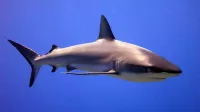Humpback whales are baleen whales, specifically rorquals, belonging to the genus Megaptera. Adults typically measure 14–17 meters in length and weigh up to 40 tons. They are identifiable by their unique body shape, long pectoral fins, and tubercles on their heads. Known for behaviors like breaching, they're popular in whale watching. Male humpbacks are also noted for their complex songs, which can range from 4 to 33 minutes in duration.
1932: Kellogg Reverts Species Name
In 1932, Remington Kellogg reverted the species name of the Humpback whale to use Borowski's novaeangliae.
1946: International Whaling Commission (IWC) Founded
In 1946, the International Whaling Commission (IWC) was founded to oversee the whaling industry, impose hunting regulations, and create hunting seasons.
1947: Soviet Union Under-Records Catches
Starting in 1947, the Soviet Union deliberately under-recorded its whale catches.
1966: IWC Bans Commercial Humpback Whaling
To prevent extinction, the IWC banned commercial humpback whaling in 1966, by which time the global population had been reduced to around 5,000.
1972: Soviet Union Under-Records Catches
Until 1972, the Soviet Union deliberately under-recorded its whale catches.
2004: Hunting Restricted in the Caribbean
As of 2004, Humpback whale hunting was restricted to a few animals each year off the Caribbean island of Bequia in Saint Vincent and the Grenadines.
2007: Japan Plans Humpback Whale Kill
In 2007, Japan had planned to kill 50 humpbacks under its JARPA II research program, sparking global protests.
May 2009: Super-Aggregation of Krill and Humpback Whales
In May 2009, a study found a super-aggregation of krill in Wilhelmina Bay, on the west side of the Antarctic Peninsula, with a large number of humpback whales feeding on the krill.
2010: IWC Authorizes Greenland Whale Hunt
In 2010, the IWC authorized Greenland's native population to hunt a few humpback whales during the following three years.
2013: Increase in Stranded Humpback Whales
Between 2013 and 2016, the number of stranded Humpback whales doubled when compared to the number of stranded Humpback whales between January 2016 and February 2019.
2013: Ship-Whale Collisions
Since at least 2013, around the Strait of Magellan, humpbacks have been the whale species that is most commonly reported to be involved in ship-whale collisions.
2014: Genetic Study Suggests Subspecies
A 2014 genetic study suggested that the separate populations of Humpback whales in the North Atlantic, North Pacific, and Southern Oceans have had limited gene flow and are distinct enough to be subspecies.
2014: Orcas Attack Young Humpbacks
A 2014 study in Western Australia observed that when available in large numbers, young humpbacks can be attacked and sometimes killed by orcas. Mothers and adults escort calves to deter such predation.
January 2016: Increase in Stranded Humpback Whales
Between January 2016 and February 2019, NOAA recorded 88 stranded humpback whales along the Atlantic coast of the US, more than double the number stranded between 2013 and 2016.
April 2017: Unusual Mortality Event Declared
In April 2017, NOAA declared an unusual mortality event due to the increase in stranded humpback whales.
2018: Genomic Analysis of Rorquals
A 2018 genomic analysis estimated that rorquals diverged from other baleen whales in the late Miocene, between 10.5 and 7.5 million years ago, and the humpback and fin whales were found to be sister taxons.
2018: IUCN Lists Humpback Whale as of Least Concern
As of 2018, the IUCN Red List lists the humpback whale as of least concern, with a worldwide population of around 135,000 whales.
February 2019: Increase in Stranded Humpback Whales
Between January 2016 and February 2019, NOAA recorded 88 stranded humpback whales along the Atlantic coast of the US, more than double the number stranded between 2013 and 2016.
2019: Oil Does Not Foul Baleen
While oil ingestion is a risk for whales, a 2019 study found that oil did not foul baleen and instead was easily rinsed by flowing water.
2020: Great White Shark Attacks Humpback Whale
In 2020, a documented incident by marine biologists Dines and Gennari et al. described a pair of great white sharks attacking and killing a live adult humpback whale.
2023: Singing Becomes Less Common
A 2023 study found that as humpback whale numbers have recovered from whaling, singing has become less common.
Mentioned in this timeline
The Union of Soviet Socialist Republics USSR existed from to...
Japan is an East Asian island country situated in the...
Australia officially the Commonwealth of Australia encompasses the Australian mainland...

Sharks are cartilaginous fish belonging to the group Selachii characterized...
Hawaii is a U S state located in the Pacific...

In Christianity a saint is a person recognized for exceptional...
Trending

1 month ago JoJo Siwa and Chris Hughes: Relationship timeline and potential break-up rumors.

1 month ago Jason Statham's 'A Working Man' achieves streaming success despite mixed reviews, replacing The Beekeeper.
28 days ago Tosh Lupoi Expected to Become Cal's New Head Coach From Oregon
William Will Stein is an American football coach currently serving as the offensive coordinator and quarterbacks coach at the University...
3 months ago Jeff Hiller's Rise: From Comedy to Emmy Glory and Stern Show Debut.
Kenyon Sadiq is an American college football player who plays tight end for the Oregon Ducks As a collegiate athlete...
Popular

Stranger Things created by the Duffer Brothers is a popular...

XXXTentacion born Jahseh Dwayne Ricardo Onfroy was a controversial yet...
Turning Point USA TPUSA is an American nonprofit organization founded...

Candace Owens is an American conservative political commentator and author...

Melania Trump a Slovenian-American former model has served as First...

Bernie Sanders is a prominent American politician currently serving as...
